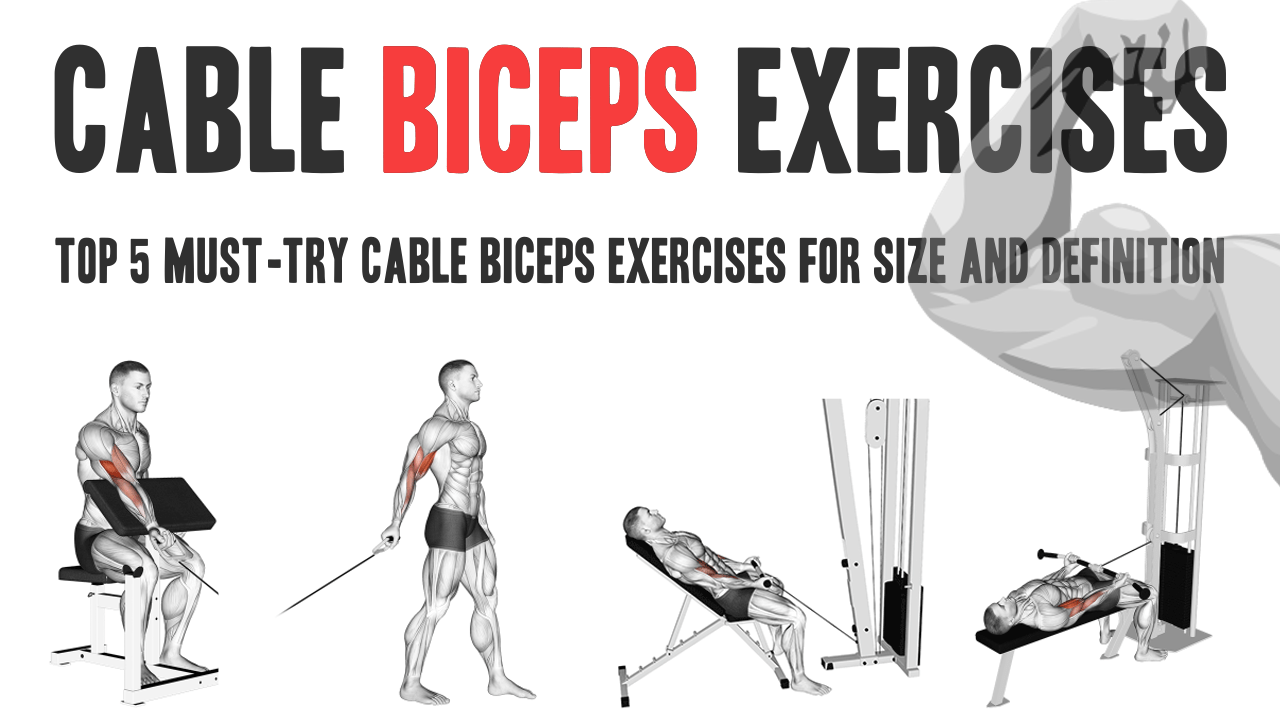Contents
Are you ready to take your biceps to the next level? When it comes to building impressive biceps, cable exercises can be a game-changer. Whether you’re a beginner looking to sculpt your arms or an experienced lifter aiming to break through plateaus, cable exercises offer a dynamic range of benefits that can take your bicep training to the next level.
Introduction:
Biceps are often considered the hallmark of a strong physique, and achieving well-defined biceps requires the right exercises and techniques.
Muscle hypertrophy, or growth, is a result of various factors, including mechanical tension, metabolic stress, and muscle damage. Cable biceps exercises excel in providing mechanical tension due to the continuous resistance and controlled movement. The tension created during cable curls stimulates muscle fibers to adapt and grow.
Moreover, the metabolic stress caused by the consistent tension and controlled pace of cable exercises contributes to hypertrophy. Metabolic stress triggers the release of growth factors and hormones, which promote muscle growth and repair. Furthermore, cable exercises allow for constant tension during both the concentric (lifting) and eccentric (lowering) phases of the movement. This prolonged tension contributes to greater muscle activation and, subsequently, muscle growth.
Advantages of Cable Biceps Exercises:
1- Isolation:
Cable exercises excel at isolating specific muscles, including the biceps. Cable exercises allow you to isolate the biceps muscles more effectively than some compound movements. This can be particularly beneficial when you want to focus solely on biceps development.
2- Unilateral Focus:
Cable biceps exercises provide the option for unilateral training, which involves working one arm at a time. This helps to address muscle imbalances that might occur due to dominant arm usage in daily activities. Unilateral exercises ensure that each arm receives equal attention, contributing to balanced muscle development and reducing the risk of asymmetry.
3- Variety of Angles:
Cable machines feature adjustable pulleys, allowing you to perform biceps exercises from various angles. This versatility lets you target different parts of the biceps, such as the outer or inner head, contributing to a well-rounded and sculpted arm appearance. Experimenting with different angles can also prevent plateaus and keep your workouts interesting.
4- Less Strain on Joints:
Cable exercises put less stress on your wrists and elbows compared to some free weight exercises. This can be advantageous for individuals who have joint issues or discomfort during traditional biceps movements.
5- Controlled Movement:
Cables require controlled movements due to the nature of the pulley system. This controlled movement not only reduces the risk of using momentum but also places less strain on joints. It’s particularly beneficial for individuals who are recovering from injuries or those who are new to resistance training, as it helps maintain proper form and minimizes the chance of overexertion.
Application in Training:
When training for muscle hypertrophy (muscle growth), your workout program should focus on specific sets, reps, and rest periods that stimulate muscle fibers effectively.
1- Exercise Selection:
Choose a variety of cable biceps exercises to target different parts of the biceps muscle, such as cable curls, hammer curls, and one-arm cable curls. This variation ensures comprehensive muscle stimulation.
2- Sets and Reps:
For muscle hypertrophy, aim for moderate to high volume with a focus on muscle fatigue. A common approach is:
Sets: 3-4 sets per exercise
Reps: 8-12 repetitions per set
Select a weight that allows you to complete the desired number of reps with good form, while still challenging your muscles. As you progress, gradually increase the weight to continue challenging your muscles.
3- Intensity and Rest Periods:
Use a weight that’s challenging enough to make the last couple of reps in each set difficult, but still allows you to maintain proper form. Rest between sets is crucial:
Rest: 60-90 seconds between sets
This rest period allows enough time for your muscles to partially recover while still keeping the intensity high.
4- Frequency:
Training frequency depends on your overall workout split. You could train your biceps directly 1-2 times per week. For example, if you’re following a 4-day split, you could dedicate one day to arm training and another to more compound movements that also engage the biceps, like back exercises.
5- Progressive Overload:
To promote muscle growth, gradually increase the weight you lift over time. This concept is called progressive overload. As you get stronger, increase the weight by small increments to ensure you’re challenging your muscles adequately.
Intensity Techniques:
1. Supersets: Combine two exercises back-to-back without rest to maximize muscle activation and save time. For example, superset Cable Biceps Curl with Cable Hammer Curl.
2. Drop Sets: After completing a set, immediately reduce the weight and perform another set with minimal rest. This technique promotes muscle fatigue and hypertrophy. Apply drop sets to Cable Preacher Curl for an extra challenge.
3. Slow Eccentrics: Focus on the lowering (eccentric) phase of the movement by slowing it down. This intensifies muscle engagement and promotes muscle growth. Apply this technique to Cable Concentration Curl.
Cooldown: After completing the main routine, spend a few minutes performing static stretches for your biceps and forearms. This helps enhance flexibility and reduce post-workout muscle tightness.
5 Must-Try Cable Biceps Exercises
Get ready to watch your arms transform as you harness the power of these effective cable biceps exercises.
Cable Incline Biceps Curl
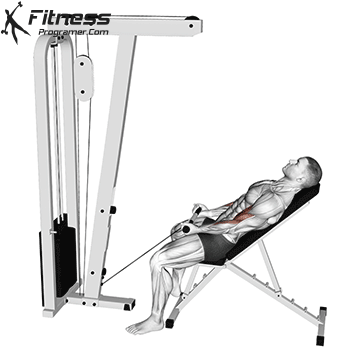
The cable incline biceps curl is a highly effective variation of the traditional biceps curl that focuses on the upper portion of your biceps. By changing the angle of the exercise, you can achieve a unique stretch and contraction in your biceps, contributing to well-rounded arm development.
Execution Steps:
- Set Up: Attach a straight bar or an EZ-bar to the lower pulley of a cable machine. Adjust a bench to a 45-degree incline angle and position it facing away from the cable machine.
- Positioning: Sit on the incline bench, your back against the backrest. Hold the bar with an underhand grip (palms facing up), hands slightly wider than shoulder-width apart.
- Initial Position: With your upper arms against the bench, fully extend your arms downward. Your elbows should be slightly behind your torso, ensuring proper alignment.
- Curling Motion: Exhale as you curl the bar upwards by flexing your elbows. Keep your upper arms stationary throughout the movement, focusing on using the biceps to lift the weight.
- Peak Contraction: Once your biceps are fully contracted and the bar is close to your shoulders, squeeze your biceps for a moment to maximize the peak contraction.
- Lowering Phase: Inhale as you slowly lower the bar back to the starting position, maintaining control and tension in your biceps.
One-arm Cable Biceps Curl
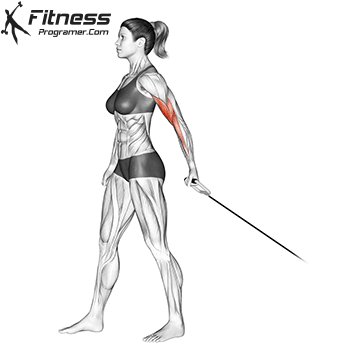
Unilateral exercises, like the one-arm cable curl, target each arm independently. This helps address muscle imbalances that might arise from everyday activities and ensures both sides of your body receive equal attention for symmetrical growth.
Execution Steps:
- Setup: Begin by attaching a D-handle to the lower pulley of the cable machine. Adjust the weight stack to an appropriate level.
- Positioning: Turn your back to the cable machine, feet shoulder-width apart. Grasp the D-handle with an underhand grip using your right hand for the right arm or left hand for the left arm.
- Initial Position: Keep your upper arm close to your torso, with your elbow slightly behind your body. Your forearm should be perpendicular to the ground, and your arm should be fully extended.
- Curling Motion: Exhale as you curl the handle towards your shoulder, contracting your biceps. Keep your upper arm stationary, ensuring that only your forearm moves.
- Peak Contraction: At the top of the movement, when your bicep is fully contracted, pause for a brief moment and squeeze before slowly lowering the handle back to the starting position.
- Lowering Phase: Inhale as you extend your arm, returning to the initial position. Maintain controlled movement throughout.
Lying Cable Curl
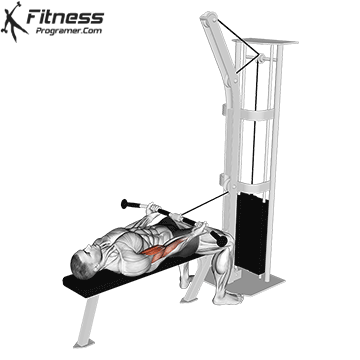
Lying on a bench provides stability, minimizing the involvement of other muscle groups during the exercise. This isolation allows for better focus on your biceps. Similar to other cable exercises, the lying cable curl maintains constant tension on your biceps. This consistent resistance optimizes muscle engagement for better results.
- Setup: Attach two single-handle attachments to the middle or upper pulleys of the cable machine. Place a bench in between the pulleys.
- Positioning: Lie down on the bench, face up. Your head should be near the top of the bench, and your feet should be flat on the ground for stability.
- Initial Position: Hold one handle in each hand with an underhand grip (palms facing up). Extend your arms fully, allowing your hands to be positioned just above your head.
- Curling Motion: Exhale as you simultaneously curl both handles towards your forehead, contracting your biceps. Keep your upper arms stationary throughout the movement.
- Peak Contraction: At the top of the movement, when your biceps are fully contracted, pause briefly and squeeze before slowly lowering the handles back to the starting position.
- Lowering Phase: Inhale as you extend your arms, returning to the initial position. Maintain controlled movement throughout.
Single Arm Cable Preacher Curl
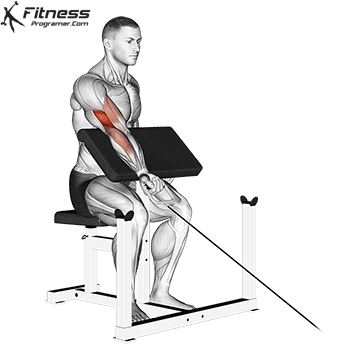
The preacher bench provides support for your upper arm, minimizing the involvement of other muscle groups and ensuring that the biceps are the primary movers during the exercise. Utilizing the cable machine maintains consistent tension on the biceps throughout the movement, promoting effective muscle activation and growth. By incorporating this exercise, you can effectively sculpt and strengthen your biceps.
Execution Steps:
- Setup: Attach a single-handle attachment to the lower pulley of the cable machine. Position a preacher bench next to the machine.
- Positioning: Sit on the preacher bench, facing the cable machine. Adjust the bench’s height so that your upper arm is comfortably placed on the padded surface.
- Initial Position: Hold the handle with an underhand grip (palms facing up), and allow your arm to fully extend, placing your upper arm against the preacher bench.
- Curling Motion: Exhale as you curl the handle towards your shoulder, contracting your biceps. Keep your upper arm stationary against the bench throughout the movement.
- Peak Contraction: At the top of the movement, when your bicep is fully contracted, pause briefly and squeeze before slowly lowering the handle back to the starting position.
- Lowering Phase: Inhale as you extend your arm, returning to the initial position with control and maintaining the preacher bench’s support.
Cable Rope Hammer Curl

The cable rope hammer curl is a versatile biceps exercise that not only targets the biceps brachii but also engages the brachialis muscle, leading to a well-rounded and aesthetically pleasing arm development. By using a rope attachment and the cable machine, you can achieve a unique grip and resistance that promotes effective muscle engagement.
Execution Steps:
- Setup: Attach a rope handle to the lower pulley of the cable machine. Stand facing the machine with your feet shoulder-width apart.
- Grip: Hold the rope handles with a neutral grip (palms facing each other), allowing your arms to fully extend downward.
- Initial Position: Keep your upper arms close to your torso, and your elbows slightly bent. Your upper arms should remain stationary throughout the exercise.
- Curling Motion: Exhale as you curl the rope handles towards your shoulders, focusing on contracting your biceps and brachialis muscles.
- Peak Contraction: At the top of the movement, when your arms are fully curled, pause and squeeze your biceps and brachialis muscles before slowly lowering the handles.
- Lowering Phase: Inhale as you extend your arms, returning to the starting position while maintaining control.
References:
Physiological and Neural Adaptations to Eccentric Exercise: Mechanisms and Considerations for Training. Biomed Res Int. Published 2015 Oct 12. doi: 10.1155/2015/193741 PMCID: PMC4620252
The mechanisms of muscle hypertrophy and their application to resistance training J Strength Cond Res. 2010 Oct;24(10):2857-72. doi: 10.1519/JSC.0b013e3181e840f3. PMID: 20847704

